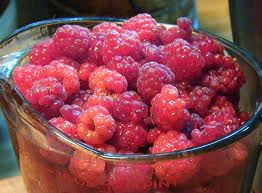Watering Raspberries
Plentiful water is important for raspberries from spring until after harvest. Because the root system is in the top two feet of soil, watering regularly is more beneficial than an occasional deep soaking. Raspberries need 1 to 1.5 inches of water per week from flowering until harvest. Use a rain gauge or check reported rainfall, and irrigate accordingly. We recommend a soaker hose set along the length of the berry bed for best watering results.
Fertilizing Raspberries
Raspberry plants need to be fertilized. Once the planting is established, fertilize yearly by the first of May. Give each plant a cup of slow release organic granular fertilizer. Do not apply all fertilizer at the base of the plant, but spread it over the entire area of the bed.
Mulching Raspberries
Raspberries benefit from mulching. Good mulches for use in the home garden include chopped leaves, and wood chips or shavings, shredded pine bark, or straw. You should keep a 3 to 4 inch layer of this organic mulch on the raspberry bed 365 days a year.
Pruning Raspberries
Raspberries grow vigorously and need to be pruned yearly. Pruning practices depend on the type of raspberry grown.
Summer-bearing red and yellow raspberries: After the last harvest, cut all canes that have produced fruit to ground level and remove them. This eliminates a disease source and gives canes more room to grow. Thin canes to 4 to 5 sturdy canes per foot of row. In areas where winter injury is common, you may delay thinning the canes until the following spring, when you will be able to tell which canes have survived. Cane growth may be somewhat less under this delayed-thinning method, due to competition among new canes. Before growth starts in spring, cutting the canes to about 12 inches above the wire is desirable. Don’t cut back more than 25% of each cane, to avoid reducing yield.
Fall-bearing raspberries: If only a fall crop is desired, cut all canes off at the base before growth begins in spring. Fruit will be produced on canes in late summer or fall.
Care of Raspberries
Watering Raspberries
Plentiful water is important for raspberries from spring until after harvest. Because the root system is in the top two feet of soil, watering regularly is more beneficial than an occasional deep soaking. Raspberries need 1 to 1.5 inches of water per week from flowering until harvest. Use a rain gauge or check reported rainfall, and irrigate accordingly. We recommend a soaker hose set along the length of the berry bed for best watering results.
Fertilizing Raspberries
Raspberry plants need to be fertilized. Once the planting is established, fertilize yearly by the first of May. Give each plant a cup of slow release organic granular fertilizer. Do not apply all fertilizer at the base of the plant, but spread it over the entire area of the bed.
Mulching Raspberries
Raspberries benefit from mulching. Good mulches for use in the home garden include chopped leaves, and wood chips or shavings, shredded pine bark, or straw. You should keep a 3 to 4 inch layer of this organic mulch on the raspberry bed 365 days a year.
Pruning Raspberries

Raspberries grow vigorously and need to be pruned yearly. Pruning practices depend on the type of raspberry grown.
Summer-bearing red and yellow raspberries: After the last harvest, cut all canes that have produced fruit to ground level and remove them. This eliminates a disease source and gives canes more room to grow. Thin canes to 4 to 5 sturdy canes per foot of row. In areas where winter injury is common, you may delay thinning the canes until the following spring, when you will be able to tell which canes have survived. Cane growth may be somewhat less under this delayed-thinning method, due to competition among new canes. Before growth starts in spring, cutting the canes to about 12 inches above the wire is desirable. Don’t cut back more than 25% of each cane, to avoid reducing yield.
Fall-bearing raspberries: If only a fall crop is desired, cut all canes off at the base before growth begins in spring. Fruit will be produced on canes in late summer or fall.
Harvest

Pick fruit every 3 or 4 days. Regular picking helps avoid some disease and insect pests that like overripe and rotting fruit. When berries are ripe, they are quite easy to pull off the receptacle or plug (the portion that remains on the plant). Pick into a shallow container to prevent crushing the
fruit. To extend shelf life, avoid picking when berries are wet, and refrigerate as soon as possible.
Pick fruit every 3 or 4 days. Regular picking helps avoid some disease and insect pests that like overripe and rotting fruit. When berries are ripe, they are quite easy to pull off the receptacle or plug (the portion that remains on the plant). Pick into a shallow container to prevent crushing the
fruit. To extend shelf life, avoid picking when berries are wet, and refrigerate as soon as possible.

